SUCCESS STORY
An In-Depth Analysis of How Louisiana's #1 School District Achieved Consistent Student Growth in Science Through Teacher-Led Transformation and Strategic Partnership
Powered by Teachers, Backed by Partnership: How Ascension Parish Sustains Science Excellence with IQWST & OpenSciEd

Two Years Later: The Next Chapter in Ascension’s Successful Science Transformation
In 2022, we shared how Ascension Parish Schools in Louisiana took bold steps to recover from pandemic learning loss by implementing a custom hybrid science curriculum from Activate Learning using IQWST and OpenSciEd, both Tier 1-rated middle school curricula aligned with the Next Generation Science Standards (NGSS). Their goal was to align instruction to the state’s unique science standards and provide teachers with an investigation-centered approach to engage all students in meaningful growth and hands-on learning that fosters scientific thinking.
At the time, Ascension Parish was just two years into its partnership with Activate Learning, which began in 2020. In those early days of curriculum adoption, Ascension teachers were navigating new expectations around three-dimensional, investigation-centered instruction while adapting to remote teaching during the height of the COVID-19 pandemic.
Ascension’s district-wide vision was crystal clear, but realizing it required strategic leadership, robust support, and a long-term commitment to instructional change and its mission to “provide every child the high-quality education necessary to succeed in an ever-changing world.”
Activate Learning provided an end‑to‑end implementation strategy that included:
- A custom hybrid IQWST/OpenSciEd curriculum aligned to Louisiana’s NGSS‑based standards, making state alignment effortless
. - Science kits and instructional materials
. - Ongoing, personalized professional learning for teachers
. - An interactive digital platform for educators and students.
The impact of Ascension’s shift to investigation-centered science was immediate in both student work and classroom culture. As Erin Babin, Ed.D. (Curriculum Specialist at Ascension Parish) reflected in our 2022 case study, “When you walk in a classroom, the models that kids are making now, and that they're thinking, analyzing, evaluating, and making decisions on are really high quality. We never saw that before we started implementing IQWST and OpenSciEd!”
Fast forward to 2025. What started as an ambitious implementation of their first formal science curriculum in 2020 has blossomed into a district-wide transformation, yielding extraordinary results. Ascension Parish has become one of Louisiana’s most remarkable education success stories — now Louisiana’s #1-ranked school system, with 53% of students in grades 3–12 scoring Mastery or Advanced on the LEAP assessment (a five-point increase since 2021 that reflects the district’s bold, system-wide push for academic excellence).
While this growth spans multiple subjects and grade levels, science (particularly in 7th grade) has seen standout gains. Since 2022, 7th grade science mastery rates have climbed from 44% to 52%, an eight-point leap supported by Ascension’s deepening use of Activate Learning’s IQWST and OpenSciEd curricula. The results highlight how strategic partners, NGSS-aligned curriculum, and sustained teacher support can lead to measurable gains in student learning.
But what sets this story apart isn’t just the data; it’s how Ascension Parish achieved these gains. This is a story of intentional, strategic change management: a shared vision, deep alignment between school district and curriculum partner, and teacher-led transformation supported every step of the way.
In this follow-up to Ascension’s first success story we shared in 2022, we take a closer look at the strategy behind the district’s continuous rise and how it’s setting a new bar for what science education can look like when teachers are trusted to lead. You’ll also meet two standout 7th grade teachers, Dollie Green of Galvez Middle School and Michelle Letourneau of St. Amant Middle School, whose classrooms show exactly what curriculum change management looks like in action.
How Ascension Parish and Activate Learning Developed a Blueprint for Sustained Success
In an era defined by shifting academic standards, increasing teacher burnout, and the fast-approaching wave of AI and automation in education, districts like Ascension Parish understand that meaningful change management isn’t optional; it’s urgent. Preparing students for the future of work and life requires more than adopting a new curriculum, it demands a cultural shift in how science is taught, supported, and experienced in the classroom. For that transformation to take root, it must be rooted in a shared belief system that empowers teachers, prioritizes student growth, and stays responsive to real classroom needs.
Change management in K-12 education refers to guiding teachers, schools, and entire districts through the successful adoption of new instructional practices, tools, or policies. For science educators implementing NGSS-aligned, three-dimensional learning that will truly prepare students for the future of work, this shift isn’t just about using new materials; it’s about reshaping pedagogy, redefining student success, and rethinking classroom culture. That kind of transition takes more than training. It requires sustained, adaptive support.
What made the difference for Ascension Parish? A partnership with Activate Learning built on shared foundational values and a unique approach to teacher empowerment.
From the start, Activate Learning did more than deliver a Tier 1-rated science curriculum. Our professional learning team became a responsive thought partner, co-designing a multi-year plan that helped Ascension bring their hybrid IQWST/OpenSciEd implementation to life, while simultaneously building capacity with teachers to lead that change from within.
Activate Learning listened first. Teachers were never asked to “figure it out” alone. They were supported at every step by a team that believed in their leadership and empowered them to own the change.
The success of the partnership rests on three key pillars that have driven innovative change management and transformative science teaching for Ascension:
- Personalized professional learning rather than standard one-size-fits-all solutions. Activate Learning's facilitators worked directly with Ascension's leadership to understand their vision and create tailored support for teachers at different stages of implementation.
- In-classroom coaching alongside teachers brought theory into practice. Activate Learning's team didn't just explain the curriculum; they demonstrated it. Facilitators entered classrooms across all nine middle schools, modeling how to effectively use inquiry tools like the Driving Question Board while focusing lessons around compelling phenomena. Science teachers from across the district observed these demonstration lessons, followed by structured debriefing sessions where teachers could discuss implementation strategies, ask questions, and collaboratively plan their own approaches.
- Evolving with the district's changing needs. What began as implementation support has grown into a dynamic, collaborative partnership that now focuses on real-time assessment strategies and equipping teachers to take on greater instructional leadership within their schools.
Erin Babin's vision and leadership were pivotal in Ascension’s success. She co-designed the district’s innovative science strategy with Chief Instructional Director, Edith Walker, and ensured teachers had the support they needed to make it work. From the start, she prioritized high-quality, responsive, professional learning that would grow with teachers.
Babin worked closely with Activate Learning to build a plan from the ground up that reflected the district’s evolving needs and goals. “Our partnership with Activate Learning has been crucial,” she explains. “When we first started, we needed professional development. We didn't know what we didn't know. Activate Learning came in and did professional development for us. We became more confident as we've evolved, and their support has evolved with us. It wasn’t a previously designed PD that we had to choose from. We were allowed to take the reins and design it the way we wanted, and they came in and provided exactly what we needed.”
Activate Learning’s flexible, responsive approach to professional learning and curriculum implementation deeply aligns with Ascension’s mission: to empower teachers with the tools and support they need to succeed. In this partnership, supporting teachers isn’t just part of the strategy: teachers are the strategy!
This customized approach to professional learning has yielded impressive results across the district. Ascension Parish has seen its most dramatic gains in 7th grade science, where mastery rates increased by eight percentage points (from 44% in 2022 to 52% in 2024).
In the following sections, we introduce you to two exceptional 7th grade teachers who exemplify what successful curriculum change management looks like in practice. Both educators bring passion, clarity, and enthusiasm to their work. Their reflections offer an honest, on-the-ground look at what it takes to implement meaningful science instruction that sticks.
Professional Learning That Empowers Teachers to Drive Change Where It Matters
Most: In the Classroom

From Veteran to Visionary: Dollie Green at Galvez Middle School
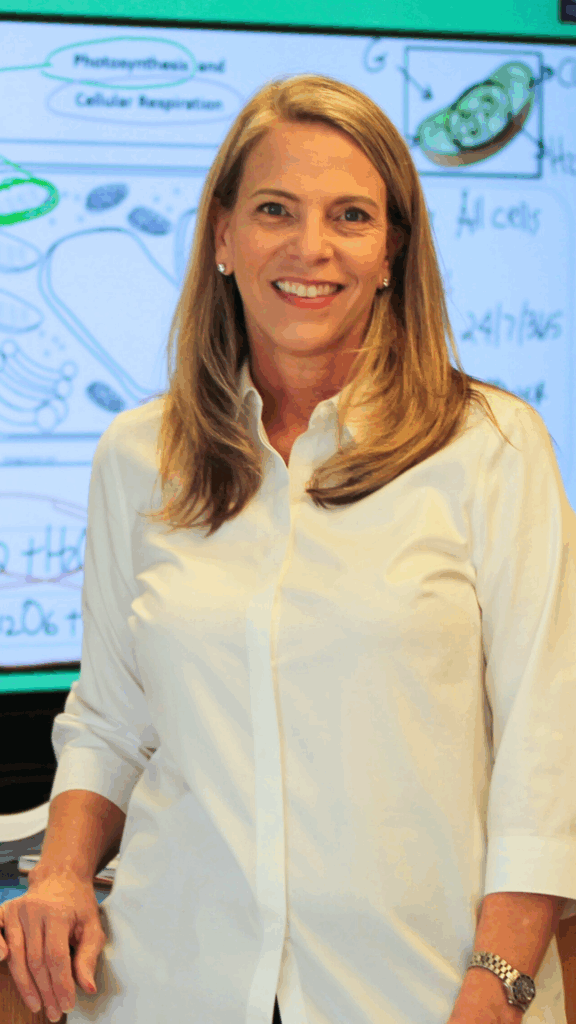
Dolly Green, 7th grade science teacher (Galvez Middle School)
Few teachers represent the power of sustained instructional change quite like Dollie Green. A veteran science educator at Galvez Middle School, Dollie Green has spent over three decades in the classroom. But it wasn’t until Ascension adopted Activate Learning’s hybrid IQWST/OpenSciEd curriculum in 2020 that she found a framework that challenged her teaching habits and transformed how her students experienced science. Returning from pandemic disruption, Dollie faced a new curriculum and students split between in-person and remote learning; a daunting shift. What makes her story so compelling is her candid acknowledgment of those early challenges, which many teachers new to NGSS-aligned instruction will recognize.
"When I first started teaching, the way you taught science was to define the words and answer the questions in the back of the textbook," Dollie explains. "It's been a huge jump to learn how to get the kids to become participants in their learning journey, rather than just sitting at their desks answering questions—making science active every day and taking time to allow kids to think about what they were doing and not just memorize the facts, but to think about what is going on in the unit. What does it mean?"
Dollie’s transition meant unlearning decades of traditional science instruction. But over time, with consistent professional learning support and her own commitment to growth, she adapted and began to see the positive learning outcomes in her students.
Two key curriculum implementation strategies she learned from professional learning sessions have proven particularly valuable in Dollie's classroom:
- Modeling: A core science and engineering practice that emphasizes the use of representations to understand and explain phenomena. Instead of simply writing about science concepts, students visually represent their understanding, revealing gaps in knowledge and creating space for a deeper understanding of scientific concepts. “Modeling has been phenomenal because it makes the kids slow down and think about what they know,” says Dollie. “They get to show what they envision in their head. So you can ask questions like, ‘How did you get from here to here?’ or ‘What part didn’t you include?’ It gets them to think deeper. That was a big piece of the new teaching for me.”
. - I-Squared: A strategy that helps students think like biologists and move beyond memorization by thinking through the science behind what they observe. “It’s the ‘my claim and my evidence’—this is what I see, and this is what I think it means. That’s the strategy I love and use all the time,” shares Dollie.
The flexibility of the curriculum allows teachers to be creative with the engagement tools. When implementing the Driving Question Board, a central element of the curriculum used at the beginning of each unit to capture students' questions about phenomena, Dollie personalizes the experience for students by integrating student questions directly into lesson slides, crediting students by name. "The kids look for their names. It encourages them to write stronger questions so they might be included in a later lesson," she shares.
For vocabulary, she adapted the curriculum's word wall approach by creating anchor charts (visual summaries that connect terminology with concepts) and placing them throughout her classroom. "I tell the kids, it's not cheating if you're looking at the anchor chart. It's there for you as a resource."
The hands-on nature of the curriculum also makes learning "sticky," as Dollie puts it. "I can teach about dialysis tubing and how we saw that it was semi-permeable today, and weeks later, students still recall key experiments because they were relevant.”
These curriculum strategies and ongoing professional learning support have enabled Dollie to create a classroom experience that reflects what real science learning looks like. Students think deeply, build and revise models, and remember key concepts because the learning is hands-on, relevant, and connected.
What do Dollie’s students think of this new way of learning science? They’re more excited and engaged than ever.
.
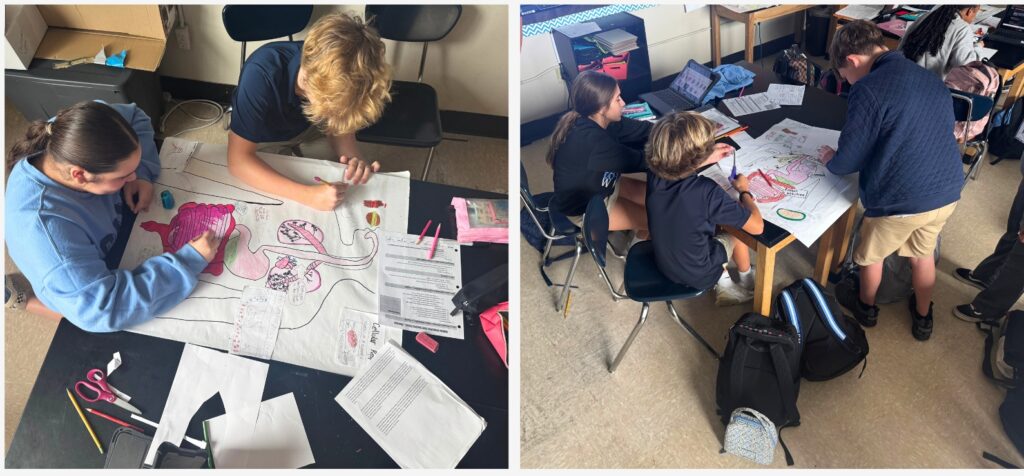
Students in Dollie Green's 7th grade class working on OpenSciEd Unit 7.3 (Metabolic Reactions - M'Kenna)
.
Among the curriculum units, one clear favorite is among students is OpenSciEd’s Unit 7.3 Metabolic Reactions, which centers on a middle school student named M’Kenna who visits the doctor with alarming symptoms. Students take on the role of investigators, analyzing real-world data like doctor’s notes, endoscopy images, growth charts, and micrographs. Together, they work to uncover what happens to food after we eat it and how M’Kenna’s symptoms are all connected. It's an educational, medical mystery that makes science real and relatable for students.
“I struggle to make body systems relevant, lab-oriented, and engaging,” Dollie admits. “The way the M’Kenna unit is designed is probably my favorite because it makes it come alive. The kids are invested in what's going on with her. They're really thinking about problem-solving and trying to figure out what's wrong with her. It makes it relevant to their life.”
Dollie credits the M’Kenna story not just for engaging students but for helping her grow as an educator. “I scored so well on an observation during the ‘up/down chart’ lesson because of the thought that went into that activity,” she shared. The curriculum’s design gave her and her students meaningful opportunities to analyze data—deepening student understanding and elevating instructional quality.
The curriculum's emphasis on accessible learning for all students has been key for Dollie. "Our campus is very socioeconomically diverse,” she explains. "I've found that with different family dynamics, there are kids that come into science that have seen a lot and done a lot and others who haven't had those opportunities. Activate Learning gives everyone the same experience."
That shared experience between students fosters collaboration, deeper learning, and a strong sense of meaningful social connection. “They can have a collaborative, engaging conversation where they really get to be stakeholders and make sense of what's going on together," says Dollie.
Dollie’s story is one of persistence, personalization, and passion, and it’s making a real impact. She mentors new teachers implementing the curriculum while fostering collaboration across Galvez Middle’s science department.
Most importantly, Dollie’s journey shows other veteran educators that meaningful change is possible and that embracing something new, even after decades of experience, can reignite both student engagement and professional purpose.
What's Dollie's advice to teachers just starting out with a new three-dimensional curriculum? “Give yourself time. I would have given up if I hadn’t pushed through that first year. It’s a progression. I’m very glad we stuck with it!”
.
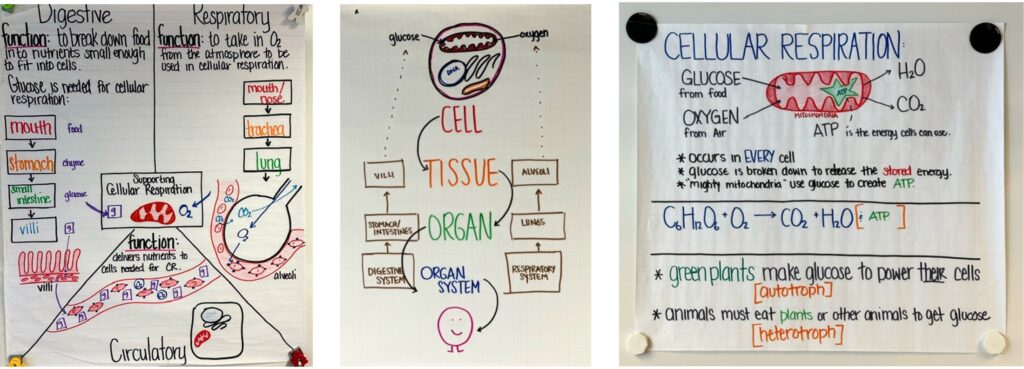
Drawings, created during the M’Kenna unit on metabolism, show how Dollie Green’s 7th grade students visually modeled cellular processes—analyzing data, making sense of phenomena, and demonstrating deep understanding through science practices.
Authentic Engagement: Michelle Letourneau at St. Amant Middle School
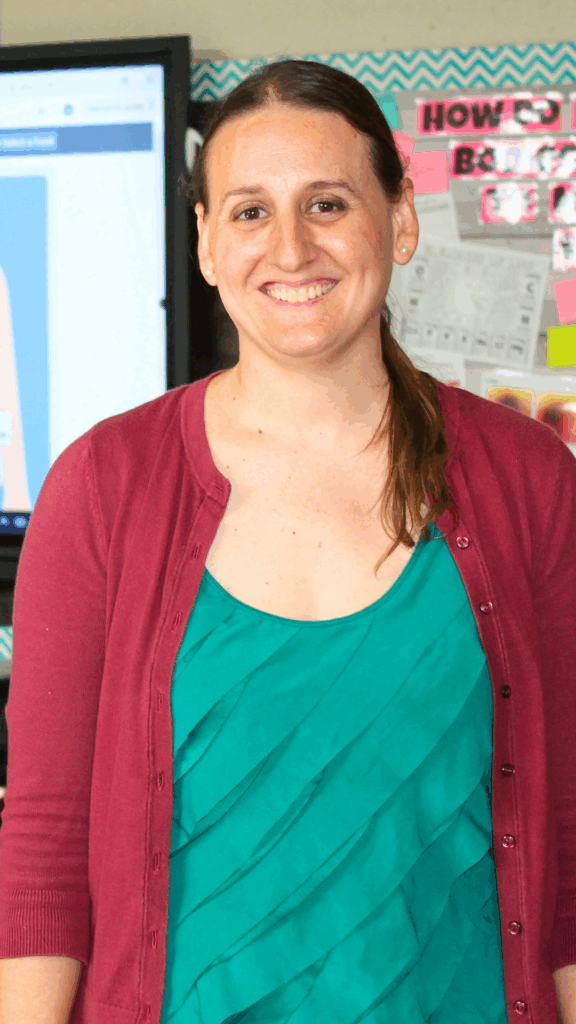
Michelle Letourneau, 7th grade science teacher at St. Amant Middle School
At St. Amant Middle School, where the mission is “Creating a Better Today and a More Promising Tomorrow,” 7th grade science teacher Michelle Letourneau is doing precisely that. As one of Ascension Parish's standout 7th grade teachers, Michelle has embraced Activate Learning's curriculum as a pathway to creating genuine student engagement and growth in her classroom.
Michelle first encountered Activate Learning’s curriculum through a pilot of the IQWST volcano unit and immediately saw a difference in how students engaged with science. “In the past, we front-loaded a lot of the material,” Michelle explains. “But with this curriculum, the kids are naturally curious and want to learn new information. They want to investigate instead of us giving it all to them.”
That shift from delivering content to facilitating discovery was a turning point in Michelle’s teaching. “When it comes to the inquiry-based learning and hands-on activities, I feel kids learn a lot more and remember a lot more when they actually get to do science rather than just read about it in a book,” she says.
Michelle values the holistic growth she observes in her students. She’s seen positive learning outcomes, especially in FAM (Formative Assessment Model) scores. “While my kids might not be the highest in the state,” she shares, “they’ve definitely grown from where they started. And I think that has a lot to do with that hands-on material.”
Michelle also highlights the curriculum’s role in building a collaborative learning environment; a critical skill for future success. “That collaborative piece is a huge part of learning nowadays,” she says. “This curriculum allows the students to work together. They collaborate. They investigate the big phenomena that we start off each unit."
She embraces what she calls "the good struggle" (giving students time to wrestle with concepts and develop their own understanding). "I feel like those hands-on activities and that time to let them struggle a little bit (the good struggle, the investigation, the time to look at it all) really has an impact on the kids."
The real payoff comes in what Michelle describes as "aha moments"; those inspiring instances of breakthrough understanding where students suddenly grasp complex concepts. "Just seeing those 'aha moments' where they get to finally put it all together and they see, 'Wow. Okay. That makes sense now!'—that's really cool to see!"
.
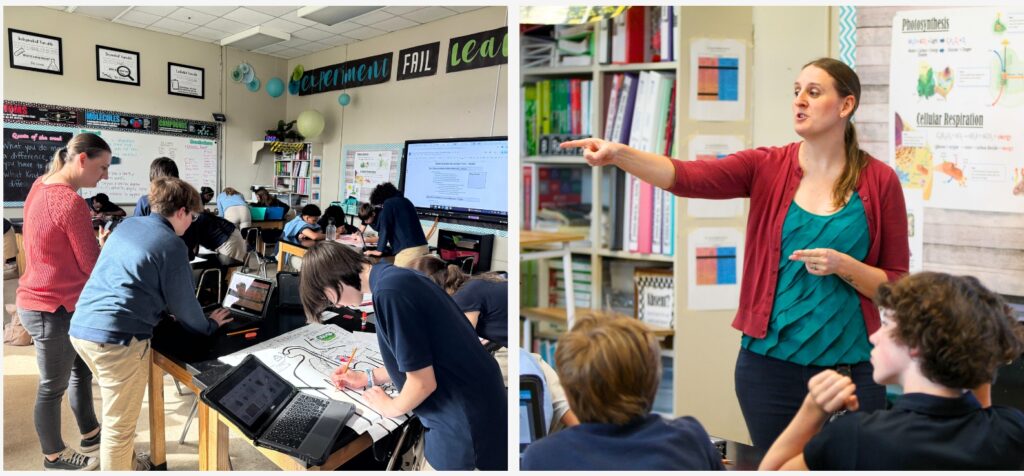
Michelle Letourneaus' facilitating hands-on learning and "aha moments" in her 7th grade science classroom.
.
Behind Michelle’s success is a strong curriculum and the support of professional learning from Activate Learning that meets teachers where they are. “It’s a difficult transition to go from what we’ve been doing for years to something new,” she acknowledges. “But having that professional development made all the difference. Our Activate Learning facilitator walked us through what to expect, how to plan, implement, and understand what students and teachers should be doing each step of the way.”
That structured support has made St. Amant’s mission manifest in substantive ways, especially for new teachers. “Our mission at at St. Amant is to grow students and future teacher leaders as well,” says Michelle. “Having this curriculum available provides that backbone of, 'Hey, these activities lead towards mastering those standards.' It gives new teachers extra information to help them so they're not struggling with everything.”
For veteran teachers like Michelle, the curriculum offers a strong foundation they can confidently build on. She sees it as a flexible framework that allows her to adapt lessons based on student needs and assessment insights, targeting gaps and deepening understanding without losing sight of Louisiana's science standards.
What advice does Michelle have for teachers embarking on this journey? “One of the best pieces of advice I received from an Activate Learning facilitator during one of our professional learning sessions is to make this your own,” reflects Michelle. “Be authentic! Students know when you’re struggling. Use this curriculum as a base, but make it your own. If you’re engaged, they’ll be engaged. And when they’re engaged, they’ll remember it and succeed!”
Success By Design: What School Districts Can Learn from Ascension’s Phenomenal Success
Ascension Parish Schools didn’t just implement a curriculum; they sparked a system-wide shift powered by teacher leadership, shared vision, and a partnership with Activate Learning that prioritized meaningful, sustained change.
This transformation didn’t happen overnight. It was shaped, over time, in classrooms like those of Dollie Green and Michelle Letourneau; dedicated 7th grade science teachers who bravely embraced a new way of teaching with perseverance and passion.
A key factor in Ascension’s success was its willingness to treat curriculum implementation as a change management challenge, not a checklist. That meant investing in teachers, not just training them. Listening to their feedback. And giving them the support, tools, and trust they need to lead and do what they do best: teach and inspire students!
District leaders looking to replicate Ascension’s success can start by asking themselves:
- Are we building internal capacity for long-term instructional leadership with ongoing teacher support?
. - Do our curriculum and assessments allow for deep, inquiry-based learning aligned with NGSS?
. - Are we partnering with providers who treat our needs as unique—not one-size-fits-all?
If the answer to any of these questions is “no,” Ascension’s story offers a powerful template for what’s possible.
As Ascension Parish continues to build on its position as Louisiana's top-performing district, the path forward remains clear: focus on the students who haven't yet reached mastery while maintaining the instructional excellence that drove their initial success.
"It's great to be number one in percent mastery in Louisiana," reflects Babin. "But we still have 40-50 percent of our students performing basic or below proficiency. Our goal is that all of these kids leave being ready to do whatever they want to do after they graduate. And we've got to do our part in middle school if we're going to get them there!"
This commitment to excellence and accessible learning for all students exemplifies the leadership principles that have guided Ascension's transformation and developed teachers into leaders of meaningful change.
Ready to create your district's science success story?
Just as Dollie and Michelle transformed their classrooms through perseverance and partnership, your teachers can lead meaningful change with the proper support. Contact Activate Learning today to discover how a strategic partnership can turn your science education vision into measurable results—one classroom, one teacher, and one "aha moment" at a time.